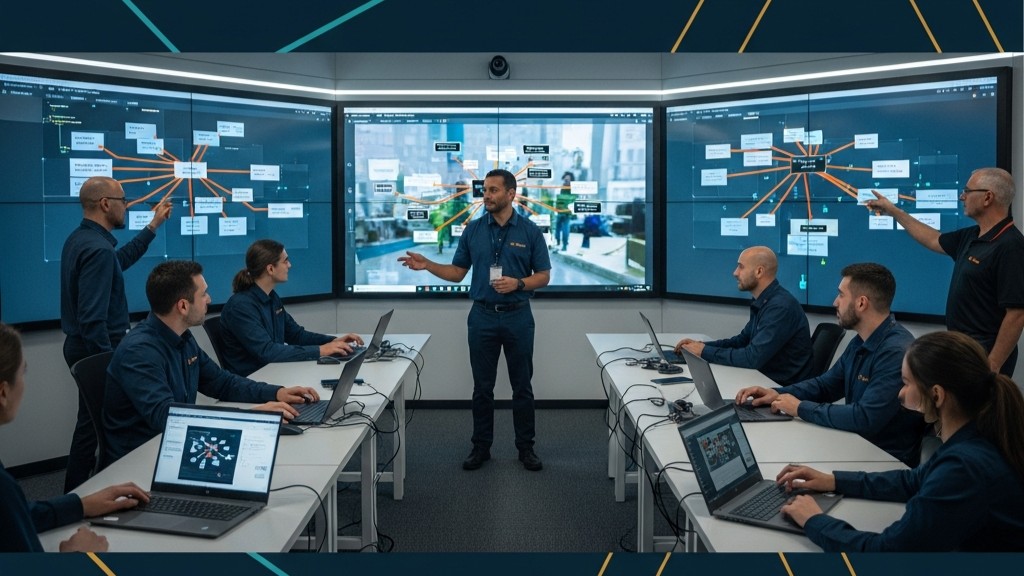What is a disaster recovery tabletop exercise?

Organizations recognize the importance of testing and validating their disaster recovery processes. Failing to do so carries financial, regulatory, reputational, and operational risk — placing the business and its people in a vulnerable position.
Tabletop exercises (TTX) are an effective way to stress test response protocols. They ensure that if disaster hits, your teams are ready.
Read on to learn what disaster recovery tabletop exercises are, their benefits and applications, and how to conduct one.
Understanding disaster recovery tabletop exercises
Disaster recovery tabletop exercises are informal, discussion-based sessions where key personnel review and validate disaster recovery plans (DRPs). Organizations use TTX simulation software solutions to increase the realism and effectiveness of exercises.
These exercises serve two primary purposes:
Organizational preparedness: Whether for a cyberattack, natural disaster, critical infrastructure failure, or similar event, tabletop exercises ensure key personnel are prepared for the unexpected.
Regulatory compliance: Tabletop exercises demonstrate to regulators that an organization proactively tests and maintains effective disaster recovery capabilities. The greater an organization’s regulatory complexity, the more regularly it should conduct tabletop exercises.
Businesses typically conduct tabletop exercises once or twice a year. Beyond regulatory complexity, company size, industry risk profile, and recent incident history also influence exercise frequency.
Disaster recovery tabletop exercises should involve all personnel who oversee or support business continuity processes. Complete stakeholder presence is important; the absence of just one key member during a tabletop exercise limits an organization’s ability to objectively assess and validate its response protocols.
Disaster recovery tabletop exercise steps
Disaster recovery tabletop exercises should lead to measurable readiness improvements. This involves three main steps: Build, run, and reflect.
1. Build
Set exercise objectives from the outset — what DRP procedures will the exercise validate? Disaster recovery tabletop exercise objectives should be specific, measurable, achievable, relevant, and time-bound (SMART). Prior to the exercise, send an email to all personnel that communicates the exercise’s objectives.
Use software, like Avalanche TTX, to build realistic simulations, enabling personnel to validate each SMART goal. Avalanche TTX’s drag-and-drop functionality lets you quickly build dynamic scenarios based on your organization's needs, from single-site exercises to multi-location crisis events. It enables you to build simple, single-site simulations in just a couple of hours. Complex, multi-site environments can take a day or two to complete.
2. Run
The exercise’s facilitator starts the TTX session — in-person, hybrid, or virtual — by outlining objectives, participant roles, and scenario details. The opening briefing may look like:
“This exercise will provide us with the opportunity to put our cyber disaster recovery plan and incident response playbooks into action. You’ll be stepping into your usual role within the organization, equipped with the tools and resources you’d typically rely on. In a moment, you will receive a phone call; from here on, the focus will be on how we communicate, coordinate, and make strategic decisions under pressure. This is an opportunity to test our readiness, identify gaps, and strengthen our collective response.”
The facilitator then introduces the scenario step-by-step, with participants talking through incident response procedures as the scenario unfolds. The exercise’s scenario-based simulation platform automatically, or via the facilitator's prompting, injects escalating complications — like secondary system outages and media inquiries. These injects test the team’s response capacity under variable, real-world conditions.
3. Reflect
Traditionally, facilitators took notes throughout the TTX session and later spent hours transcribing them into a formal after‑action report. Now, software solutions like Avalanche TTX do the work — making reporting faster and more accurate.
Avalanche TTX automatically aggregates input from all participants, timestamps responses, and compiles them into structured, audit-ready after-action reports. It gives all personnel a clear, objective view of the exercise’s outcomes in one place, which informs ongoing DRP revisions.
Disaster recovery tabletop exercises: 3 applications
Disaster recovery tabletop exercises let businesses validate a broad scope of emergency response protocols. A successful tabletop exercise identifies DRP response gaps, whether related to core infrastructural failure, a workforce availability crisis, cybersecurity threats, or other disaster scenarios.
Workforce availability crisis: Tabletop exercises let personnel stress test workforce availability crisis procedures, from early response protocols to long-term staffing stability measures.
Core infrastructure failures: From validating immediate containment to full system recovery response strategies, tabletop exercises ensure that key personnel are prepared for core infrastructural failures.
Cyberattacks: During a cybersecurity tabletop exercise, key personnel simulate and talk through realistic detection, containment, response, recovery, and evaluation processes.
Disaster recovery simulation training, made easy
Whether you’re conducting a simple, single-site exercise or a complex, multi-site session, you can increase your teams’ preparedness with Avalanche TTX.
Avalanche TTX is an all-in-one scenario-based training platform. It makes it easy to build, deliver, and report on customized simulations that realistically mirror real-world emergency scenarios. Whether preparing for regulatory validation or unforeseen events, Avalanche TTX lets you reduce risk by preparing your teams for the unexpected.
FAQ
What are tabletop exercises for disaster recovery?
During a disaster recovery tabletop exercise, key personnel discuss and simulate responses to hypothetical emergency scenarios, from cyberattacks to natural disasters. These exercises enhance organizational preparedness and support regulatory compliance.
What TTX challenges do businesses face?
In the past, traditional tabletop exercises have limited businesses in the following ways:
User disengagement: Paper-based, static workflows fail to mirror real-world scenarios. Participants view them as trivial check-box ticking, not meaningful preparation for consequential crises.
Manual-intensiveness: Traditional TTX approaches rely on physical documentation, manual data entry, and time-consuming reporting processes. This produces broad errors, from subjective exercise outcomes to costly administrative overhead.
Inflexibility: Traditional TTX approaches cannot accommodate complex, multi-site training exercises. The more complex or distributed the scenario, the less effective traditional TTX exercises are.
Avalanche TTX resolves these challenges, far surpassing the capabilities of traditional delivery methods. It’s an automation-first, all-in-one scenario-based training platform that lets you seamlessly create, deliver, and review realistic exercises — single or multi-site.
What are tabletop exercise examples?
Tabletop exercises span a broad scope of disaster scenarios, most commonly including cyberattacks, critical infrastructural failures, and natural disasters. Across all scenario types, tabletop exercises help key businesses validate and identify gaps in incident response protocols.


